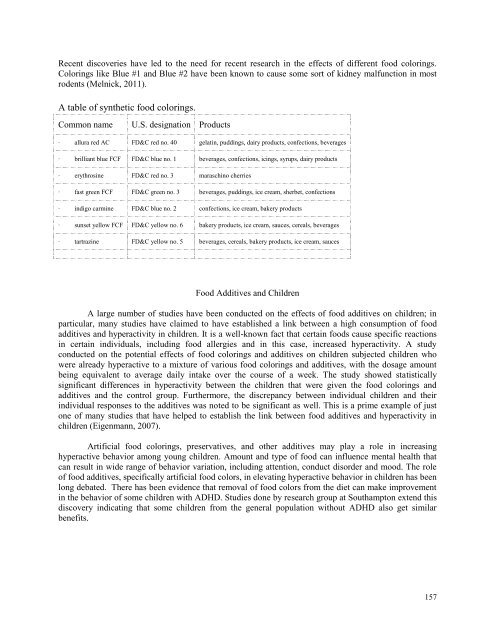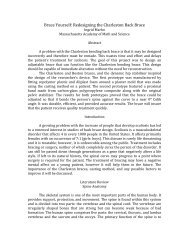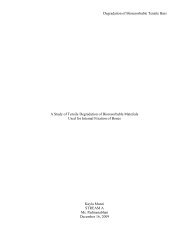Got Food? - the Scientia Review
Got Food? - the Scientia Review
Got Food? - the Scientia Review
Create successful ePaper yourself
Turn your PDF publications into a flip-book with our unique Google optimized e-Paper software.
Recent discoveries have led to <strong>the</strong> need for recent research in <strong>the</strong> effects of different food colorings.<br />
Colorings like Blue #1 and Blue #2 have been known to cause some sort of kidney malfunction in most<br />
rodents (Melnick, 2011).<br />
A table of syn<strong>the</strong>tic food colorings.<br />
Common name<br />
U.S. designation Products<br />
· allura red AC FD&C red no. 40 gelatin, puddings, dairy products, confections, beverages<br />
· brilliant blue FCF FD&C blue no. 1 beverages, confections, icings, syrups, dairy products<br />
· erythrosine FD&C red no. 3 maraschino cherries<br />
· fast green FCF FD&C green no. 3 beverages, puddings, ice cream, sherbet, confections<br />
· indigo carmine FD&C blue no. 2 confections, ice cream, bakery products<br />
· sunset yellow FCF FD&C yellow no. 6 bakery products, ice cream, sauces, cereals, beverages<br />
· tartrazine FD&C yellow no. 5 beverages, cereals, bakery products, ice cream, sauces<br />
<strong>Food</strong> Additives and Children<br />
A large number of studies have been conducted on <strong>the</strong> effects of food additives on children; in<br />
particular, many studies have claimed to have established a link between a high consumption of food<br />
additives and hyperactivity in children. It is a well-known fact that certain foods cause specific reactions<br />
in certain individuals, including food allergies and in this case, increased hyperactivity. A study<br />
conducted on <strong>the</strong> potential effects of food colorings and additives on children subjected children who<br />
were already hyperactive to a mixture of various food colorings and additives, with <strong>the</strong> dosage amount<br />
being equivalent to average daily intake over <strong>the</strong> course of a week. The study showed statistically<br />
significant differences in hyperactivity between <strong>the</strong> children that were given <strong>the</strong> food colorings and<br />
additives and <strong>the</strong> control group. Fur<strong>the</strong>rmore, <strong>the</strong> discrepancy between individual children and <strong>the</strong>ir<br />
individual responses to <strong>the</strong> additives was noted to be significant as well. This is a prime example of just<br />
one of many studies that have helped to establish <strong>the</strong> link between food additives and hyperactivity in<br />
children (Eigenmann, 2007).<br />
Artificial food colorings, preservatives, and o<strong>the</strong>r additives may play a role in increasing<br />
hyperactive behavior among young children. Amount and type of food can influence mental health that<br />
can result in wide range of behavior variation, including attention, conduct disorder and mood. The role<br />
of food additives, specifically artificial food colors, in elevating hyperactive behavior in children has been<br />
long debated. There has been evidence that removal of food colors from <strong>the</strong> diet can make improvement<br />
in <strong>the</strong> behavior of some children with ADHD. Studies done by research group at Southampton extend this<br />
discovery indicating that some children from <strong>the</strong> general population without ADHD also get similar<br />
benefits.<br />
157
















